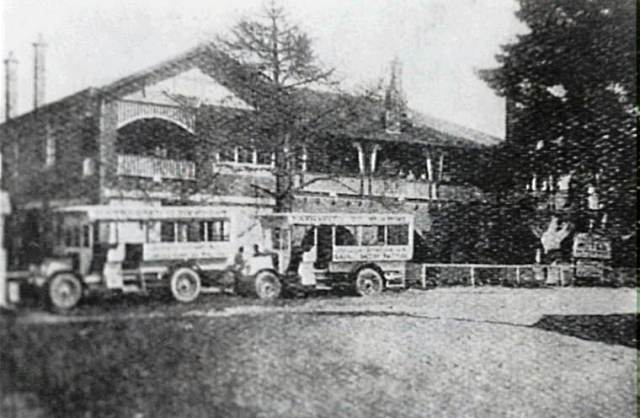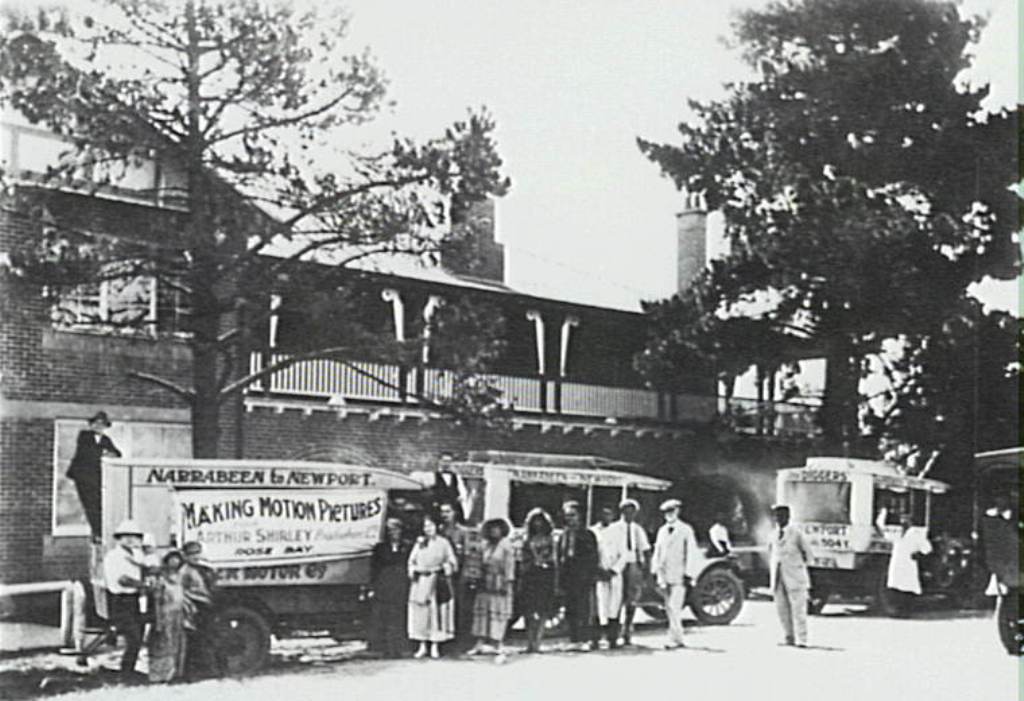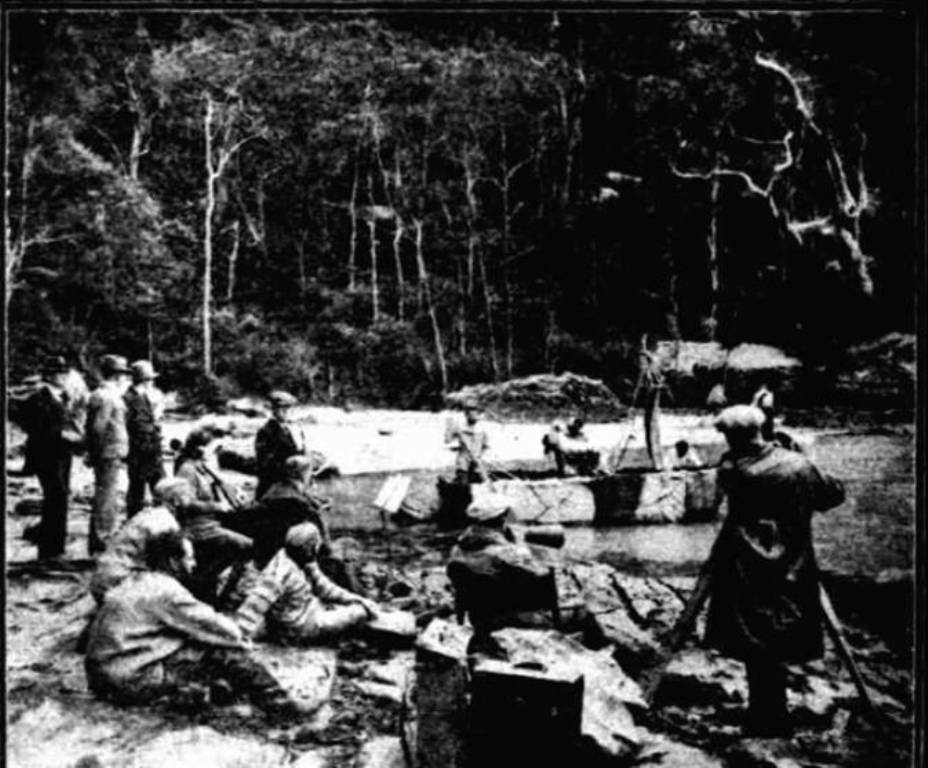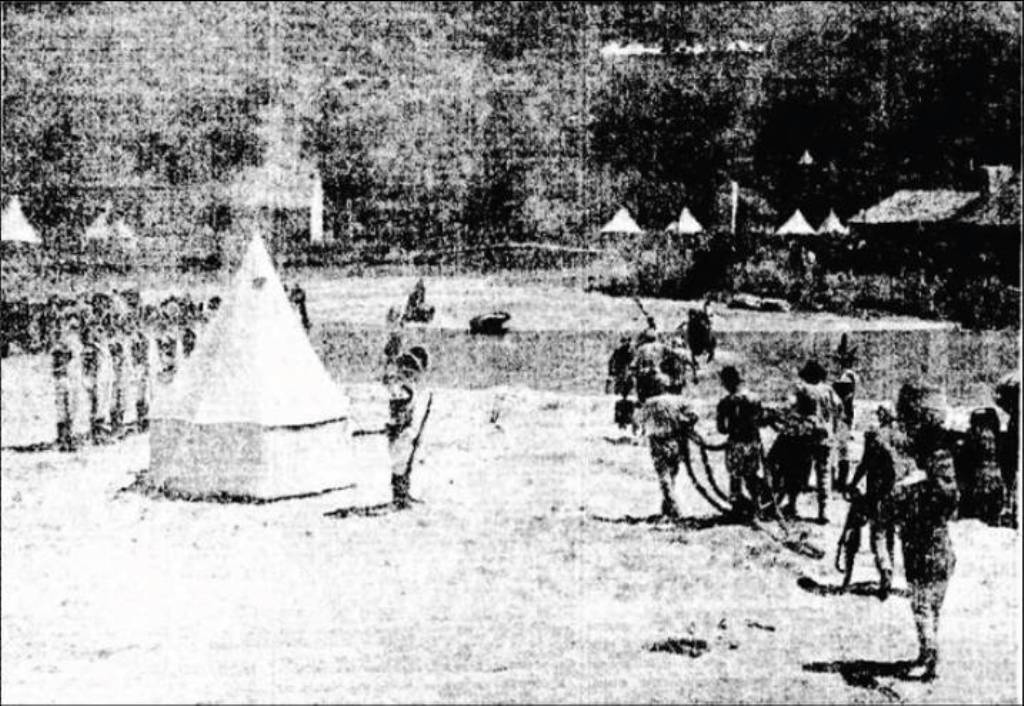January 15 -21, 2012: Issue 41
Filmed in Pittwater
The beauty of Pittwater and its pristine offshore areas have been utilised as backdrops for the creating of other worlds. Being able to see how yesterday’s landscapes and bays were, even their skies and seasons, is what gives every film, regardless of its artistic merits or lack of them, historical value to we not born or living then.
Pittwater has many local actors who have worked hard and become well known and respected thespians in their fields. Most of them began in low-budget do it for free and sometimes, locally shot productions. These film-making events provided employment for locals, whether on the sets or serving those who came to stay in local cottages and Hotels. One of the earliest is this short lived company, whose originators, went on to other great things:
BUSHRANGERS AT NARRABEEN.
REALISM FOR PICTURE SHOWS.
" Residents of Narrabeen and the Pittwater district are enjoying the exciting spectacle in their midst of stuck-up mail coaches, galloping bushrangers, and troopers, beauteous heroines on horseback, and other paraphertrialia of the good old bushranging days of New South Wales, while the hills around are .'resounding with the rifle and revolver shots of outlaws and police engaged m mortal combat on tho roads, and in the neighboring bush. Alas, it is all make-believe. It is nothing . more than the operations of the Australian ' Biograph Company, who are out on an expedition for film-making, and they have selected this beautiful and picturesque territory as a background for their pictures of ;Old Australian life and incident. A strong cast of leading actors and actresses are engaged In the strenuous work, including Miss Harrie Ireland, Mrs. and Miss Herbert, Messrs. Gaston Mervale, Godfrey Cass, and other well-known artists. Over -40 horses are employed in the operations, which are on an extensive scale. Mr. Clarke 13 in charge of the camera. The company work in, the district for a week. Out in French's Forest, in the vicinity of Oxford Falls, the Spencer Biograph Company are also engaged in the same class of task. BUSHRANGING AT NARRABEEN. (1911, January 21). The Sun (Sydney, NSW : 1910 - 1954), p. 10 (FINAL SPORTING). Retrieved from http://nla.gov.au/nla.news-article221589110
In 1925 Henry Raymond Shirley and his troupe of actors stayed at Newport Hotel whilst in Pittwater filming. In that same year he released what was to be his most successful film The Mystery of a Hansom Cab, based on the (1889) book by Fergus Hume (1859-1932) which was an Australian Whodunit based in Melbourne. This funded The Sealed Room, released in 1926; unfortunately we could find no trace of this film to identify if Pittwater provides its scenic rooms.
On November 28th 1926, Norman Dawn, producer and director of For The Term of His Natural Life, brought his actors and film crew to Pittwater to film a famous sequence from this well known book. What is also interesting in the Sunday Times Report of ‘Shooting Scenes in Newport’ is that magical Scotland Island has managed to whisk herself northwards and even up the Hawkesbury;
Newport usually awakens to life in the week-ends, when motorists and pleasure-seekers from all around Sydney find a haven of rest in the peace and quiet of its picturesque surroundings, but when Norman Dawn, producer of 'For the Term of His Natural Life,' arrived there on Thursday with a gang of artists to enact further incidents in the story, 'the popular resort possessed a sudden mid-week interest.
News of the presence of the artists spread very quickly, and those who could free themselves sped out in cars to see what was being done by those who were brought out here to show us how movies are really made when the cash is up for spending. Hunting up locations is one man's job, and quite a responsibility, in a picture containing mostly outdoor locations. Newport- proved an ideal spot, scenically, for filming outdoor scenes.

'FOR THE TERM OF HIS NATURAL LIFE.'Rains Dawes (George- Fisher) lifts Sylvia Viclters (Eva Novak) into the Coracle, and orders Capt Frero (Dunstan Webb) to push out to sea. This scene was 'shot' at Newport on Friday.
A representative of the 'Sunday Times' went out on Friday morning to watch activities, and viewed the movements of the company with the interest of one who isn't accustomed to see convicts and pretty girls trailing on the heels of a man with a megaphone, and obeying his every wish. The scene to be 'shot' was the incident where Rufus Dawes, Sylvia Vickers, and Captain Frere put out to sea in the coracle. This necessitated the company setting out from Newport by launch, cruising up the waters of the Hawkesbury, and anchoring in one of the small bays opposite Scotland Island, on the north side. Here a clever little replica of the goat-skin boat described in the novel was lying on the sand on the beach. Wet weather made the company lose no time in 'shooting' this scene, where Rufus Dawes carries Sylvia Vickers in his arms out to the coracle, and orders his one-time superior (Capt. Frere) to push off the boat.
Six 'shots' taken in the falling rain, and Eva Novak suggested the orchestra strike up 'It Ain't Gonna Ruin No More.'
'It is all for the picture,' says Norman Dawn. 'For the stake of Art,' laughed Fisher, and the violinist wondered how much rain it took to ruin a perfectly good violin. The scene finished, the camera man got a few close-ups for publicity purposes, and the company boarded the launch again. Inside, fifteen of them seated themselves in picnic fashion. A large hamper was opened, and the hungry took sufficient nourishment to last until the hotel was reached for lunch.
It had been intended that the company should remain in Newport for four days, but Dawn, believing he could get better locations for other scenes, decided to return the same afternoon. Cars were rang for, and the company returned to the Bondi Studio, and work will proceed there again to-morrow, while the scout goes out to photograph new locations for Dawn's approval.
'I cannot always tell exactly how long I will be on any one location,' says Mr. Dawn, 'it all depends on the weather, and whether I am satisfied scenically with the surroundings. I thought I would be in Newport much longer, but I am satisfied there are other locations that will provide a change of scenery, and suit the purpose of the scenes equally well. The shots are not taken in the correct sequence in which they appear in the film.
A scene in the first and fifth reel may be taken in the same day and some of the scenes in the second reel may not be taken until the picture is utmost completed.
Technically, there is much to remember. For instance, if I have taken one scene on a sunny morning, I must be careful to see that the scene which links up with it is also taken on a bright day. "SHOOTING" PEOPLE AT NEWPORT—- WITH A MOVIE CAMERA (1926, October 17). Sunday Times (Sydney, NSW : 1895 - 1930), , p. 2. Retrieved from http://nla.gov.au/nla.news-article128120686
-while a crowd of onlookers comprehend the full significance of movie-making in and around Sydney- The scene to be shot was the incident where Rufus Dawes, Sylvia Vickers, and Captain Frere put out to sea in the coracle, which necessitated the company setting out from Newport by launch, cruising up the waters of the Hawkesbury, and anchoring in one of the small bays opposite Scotland Island on the north side. Here a clever little replica of the goat-skin boat described in the novel, was lying in the sand on the beach. Wet weather made the company lose no time in shooting this scene where Rufus Dawes carries Sylvia Vickers in his arms out to the coracle, and orders his one timé superior (Capt. Frere) to push off the boat Six shots taken in the falling rain, and Eva Novak suggested the orchestra to strike up "It Ain't Gonna Rain No More." "It is all for the picture,” says Norman Dawn, "For the sake of art," laughed Fisher, and the violinist wondered how much rain it takes to ruin a perfectly good violin. The scene finished, the camera man gets a few close-ups for publicity purposes, and the company board the launch again. Inside fifteen of them are- seated quite in picnic fashion. A large hamper is opened, and the hungry take temporary nourishment until the hotel is reached for lunch. Accordingly one can understand how motion pictures involve a big outlay. Transit alone must absorb quite a figure on the expense sheet, as well as the cost in loss of time and salaries debited against inclement weather. The company intended remaining in Newport for four days, but Dawn, believing he could get better locations for other scenes, decided to return the same afternoon. Cars were rung- for, and the company returned to the Bondi studio, and work will be proceeded there again to-morrow while the Scout goes out to photograph new locations for Dawn's approval.
"I cannot always tell exactly how long I will be on any location," says Mr. Dawn. 'It all depends on the weather, and whether I am satisfied scenically with the surroundings, I thought I would be In Newport much longer, but I am satisfied there are other locations that will provide a change of scenery, and suit the purpose of the scenes equally well..." AUSTRALIAN FILM. (1926, November 28). Sunday Times (Perth, WA : 1902 - 1954), p. 3. Retrieved from http://nla.gov.au/nla.news-article58312432
Scenes in Pittwater from: For the Term of His Natural Life 1927 (cave looking like Avalon’s St Michael’s Cave?); http://aso.gov.au/titles/features/the-term-of-his-natural-life/clip1/
In 1930 Australia’s first ‘talkie’ Showgirl’s Luck was created although not released until 1931. On 15th of March 1933, iconic Australian film-maker Charles Chauvel, debuted Tasmanian born actor Errol Flynn in the only Australian film he ever appeared in, apparently due to being impressed with Flynn’s survival of being shipwrecked in New Guinea. In the Wake of the Bounty was Chauvel’s prelude to filming Heritage. 1933 was the year Mr Chauvel began dreaming up what would become the film Heritage in response to the Australian Government’s announcement, in pursuit of encouraging the Australian Film Industry, by offering a prize of £2,500 to the best Australian-made film. In October of 1934 he and wife Elsa (Elsie) were visitors to Pittwater.
Mr. and Mrs. Charles Chauvel have gone to Great Mackerel Beach, near Palm Beach, where they will occupy a cottage during the photographing of scenes for their new film, “Heritage." SOCIAL AND PERSONAL. (1934, October 20). The Sydney Morning Herald (NSW : 1842 - 1954), p. 11. Retrieved January from http://nla.gov.au/nla.news-article17119227
Heritage 1934 had long term Bayview resident John MacCallum and husband of Googie Withers as one of its players. 1934 was also a year when Australia was experiencing The Depression and locals were happy to be employed, if only for a few days:
"HERITAGE." Plans for Crowd Scenes. GOVERNOR PHILLIP'S LANDING.
More than a hundred men. most, of them unemployed, have been given work for to-day as "extras" in the Australian picture. "Heritage."' which Mr. Charles Chauvel is producing for Expeditionary Films. Ltd. Seventy of the men were selected in Sydney, and a large number in the district about Pittwater. To-day, all these will be transported to Great Mackerel Beach, where they are to take part in scenes depicting the landing of Governor Phillip.
The settings for Governor Phillip's camp have been faithfully reproduced from sketches prepared by Mr. Ray Lindsay from original sources in the Mitchell Library and elsewhere. Much difficulty has been experienced, however, in damming the small stream which flows from the hills to the beach, and which is Intended to represent the historic Tank Stream of Circular Quay. Several hundred bags, to be filled with sand for that purpose, were sent from Sydney yesterday. Hitherto, the tides have moved all the sandbags available at Pittwater.
It is hoped to make a start with the crowd scenes at Pittwater this morning. The film should be sufficiently advanced by the end of the week to be taken to Melbourne by Mr.Chauvel for "cutting." RE-ENACTING SCENES FROM THE FIRST SETTLEMENT. (1934, October 25). The Sydney Morning Herald (NSW : 1842 - 1954), p. 16. Retrieved from http://nla.gov.au/nla.news-article28021154
THAT enterprising couple, the Charles Chauvels, have found the quaintest little beach. In among the rocks and tea-tree, high above Mackerel Beach, near Pittwater, from which they will be able to keep an eye on the extras to be utilised in finishing their film, "Heritage," and, incidentally, the social-lights across the bay at Palm Beach. And what do you think they found there? Pasted on the front verandah was a large photograph of a group of those luscious Mack Sennett bathing girls, just too, too Mae Westy for words. It quite brought Charles' 'Hollywood days back to him when ho used to scamper round as one of Douglas Fairbanks' publicity men. Incidentally, this week Pittwater will resound to the commands of Governor Phillip's military, and the curses of his convict men. Nevertheless, Mrs. Chauvel thinks her little pill-box on the hill is the most restful spot since she left the Blue Lagoon in Tahiti. Catty Communications (1934, October 27). Smith's Weekly (Sydney, NSW : 1919 - 1950), p. 21. Retrieved from http://nla.gov.au/nla.news-article235490112
In 1937, Tall Timbers, which has as its opening scenes boardriders at Palm Beach and was from a story by Whale Beachian Frank Hurley, was released. Mr Hurley took a job as a cameraman with Cinesound during the work scarce Depression years. This was a silent film, despite the advances in cinema technology.
Despite a lack of accessible Australian Films, many were made during the 1940’s, 50’s and 60’s, sometimes on a wing and a prayer, but all capturing a developing sense of what is the essential Australian Spirit that lead, by the 1970’s, to what is termed ‘okerism’. The 1979 film Palm Beach filmed in, well, Palm Beach, had a cast that included Steve Bisley as your ocker and Bryan Brown as a surfboard seeking character, it’s worth taking a look at the short extracts available on ASO for the views of Palm Beach Dunes as they were in then. See: Palm Beach 1979;
http://aso.gov.au/titles/features/palm-beach/clip3/
1979 was also the year Tim was released, filmed mostly at Barrenjoey in one of the old Customs Cottages. In 1978 Narrabeen Lake played host to the film Newsfront and was cunningly disguised at the Maitland Floods of
Television also brought Pittwater to our smaller screens. Pittwater locations featuring as the fictional world of Summer Bay has brought many a visitor into our area solely to find these locations. Every second week, whilst strolling along, someone either from here or overseas stops a staffer and asks them to point the way to Summer Bay, usually with a few youngsters in the back, clearly excited.
IN 1968 Sir Robert Helpmann featured in the ABC’s ‘Contrabandits, a Pittwater production’; HELPMANN A "BADDY" “CONTRABANDITS," ABC-TV's smuggling drama series, off to a good start with its 1968 season, could become Australia's first seriesto attract famous overseas guest stars for prestige appe arances.
Starting the trend is world-famous ballet dancer and actor Sir Robert Helpmann, who plays a sinister role in "In For A Penny," to be telecast soon.
It was filmed largely at a fantastic mansion built by an Australian millionaire at Palm Beach, N.S.W.
A helicopter, private plane, a seaplane, a speedboat, and luxury cars - one once used by Princess Soraya - are all used. Even the Royal Australian Navy weighed in with its newest vessel, HMAS Archer, a fast patrol boat, which manoeuvred round Pittwater as directed by walkie-talkie.
- NAN MUSGROVE HELPMANN A "BADDY". (1968, September 11). The Australian Women's Weekly (1933 - 1982), p. 16. Retrieved from http://nla.gov.au/nla.news-article46186189
Australian masterpiece, The Year of Living Dangerously (1982) has Pittwater disguised too; Bilgola and Church Point specifically ( a local film man tells us this occurred as Peter Weir found the conditions in the Philippines, and death threats made to himself and Mel Gibson, where they were filming, too dangerous to cast and crew.) A staff member, living on Bilgola beach at the time remembers having trouble walking home as residents were directed to not be there; the roads had been covered with sand. The offshore film gent also recalls his part of our world being similarly ‘disguised’.
Successive decades have also kept for all time parts of a more ‘modern’ Pittwater that has faded. Warriewood’s Drive In Theatre, gone for a little while now, was the ‘studio lot’ for 1991’s Fatal Bond which includes brother of Mel, Donal Gibson. See; Fatal Bond 1991; http://aso.gov.au/titles/features/fatal-bond/clip2/
Lantana (2001) has also Pittwater and Broken Bay sites as part of its truer blood. Although considered quite modern, eleven years have passed since this film’s release and a lot has changed around here in that time. More buildings, more people. What hasn’t changed is what draws people here, our green spaces and the way they lend themselves to creating real ‘environment’ in any scenes that require this. Who knows how many "Wow!"s we and our home grounds will look to those who watch these a hundred years from now…
|
Film crew and actors in front of Newport Hotel standing beside 3 Narrabeen to Newport buses. Circa 1925, Image No. Courtesy of Mona Vale Library Images.
Film crew and actors in front of Newport Hotel in front of Narrabeen to Newport bus. Circa 1925 - Arthur Shirley is in pith hat.
How a movie scene is "shot." This is the scene where Rufus Dawes lifts Sylvia Vickers into the goatskin boat. Producer Norman Dawn is seen seated with megaphone. Camera-man Len. H. Boos is on his right, and an orchestra, to inspire the players into the right mood, is on the left. AUSTRALIAN FILM. (1926, November 28). Sunday Times (Perth, WA : 1902 - 1954), p. 3. Retrieved from http://nla.gov.au/nla.news-article58312432
Photograph: RE-ENACTING SCENES FROM THE FIRST SETTLEMENT. (1934, October 25). The Sydney Morning Herald (NSW : 1842 - 1954), p. 16. Retrieved from http://nla.gov.au/nla.news-article28021154 | ||

Above: Film crew and actors in front of Newport Hotel, Circa. 1925. Image No: NEW 009, Courtesy of Mona Vale Library Images
Above: The mystery of a hansom cab (1889)
Author: Hume, Fergus, 1859-1932
Publisher: Chicago, Rand, McNally
An Australian Whodunit based in Melbourne
Below: For The Term of His Natural Life (1927)
This is the greatest of all Australian Silent films. Made just before the advent of synchronised sound, this film had a limited period of commercial viabilty before it dissapeared from sight. Based on the serialised novel by Marcus Clarke, this was the most expensive film produced in Australia at the time. It costed 50,000 pounds when the average Australian film was made for around 1000 pounds.
The film stars George Fisher as Richard Devine/Rufus Dawes/John Rex and Eva Novak as Sylvia Vickers and was adapted, produced and directed by Norman Dawn, who later went to Hollwood and made classic B-grade movies like "Bowanga Bowanga" and "Two Lost Worlds".
Director: Norman Dawn, Producer: Norman Dawn
Production Company: Australasian Films
Below: In The Wake of the Bounty (1933)
Director: Charles Chauvel
Producer: Charles Chauvel
Production Company: Expeditionary Films
Audio/Visual: sound, B/W
"In The Wake of The Bounty" is Errol Flynn's first film. It is also the first of two of Charles Chauvel's proposed series of docudrama's which would be part narrative and part travelogue. The other is "Heritage"
For the trivia buffs:
-Errol Flynn was a decendant of Fletcher Christian, the character he plays in this film.
-This incident in history has also been explored in "Mutiny on the Bounty", in 1935 with Charles Laughton and Clarke Gable and in 1962 Trevor Howard and Marlon Brando and again in "The Bounty" 1984 with Anthony Hopkins and Mel Gibson.
-MGM used parts of "In The Wake Of the Bounty" to create advertising featurettes for the 1935 version: "Primitive Pitcarn" and "Pitcarn Island Today"
Not Filmed In Pittwater but part of our Manly Beach History and Heritage
Below: The Sentimental Bloke (1919)
Director: Raymond Longford
Producer: Raymond Longford
Production Company: Southern Cross Feature Film Company
The film is based on C.J. Dennis' 1915 Australian poem The Songs of a Sentimental Bloke, a favourite of many WWI Australian soldiers. The film was produce by a South Australian company, The Southern Cross Feature film Co, and shot in New South Wales. Most of the exteriors were filmed in the Sydney suburbs of Woolloomooloo, Manly Beach, Bondi and The Royal Botanical Gardens, Sydney. Interiors were shot at Wonderland City in Bondi. The text on the inter-titles (designed by Lyell) was taken directly from Dennis' poem.
Raymond Longford and Lottie Lyell, the writers/directors/stars were the most successful film partnership in Australia at the time. This film broke all existing box office records after debuting on October 4 1919 at Melbourne Town Hall in Victoria.
This version comes from a second generation VHS copy from a U-Matic video tape distributed by the New South Wales Department of Education in the early 1980s. This is an incomplete version of the film which is Public Domain as all motion picture and literary copyrights in this version have expired under Australian Law.
The negative of this film was recently discovered in the archives of George Eastman House (mislabled "The Sentimental Blonde"). The copyright restored edition premiered in 2004.
There is no musical accompaniment on this video. It is completely silent.
Further
Comprehensive list of Australian Films 1896 -2011: http://en.wikipedia.org/wiki/Australian_films:_1896_-_1919
Australian Screen Organisation’s Australian Newsreels: http://aso.gov.au/titles/newsreels/
The 1950s
1950: Film festival planning pow-wow held
In January 1950 at Newport beach in Sydney, the NSW Federation of Film Societies hosted a weekend conference for interstate film society representatives. The outcome of the meeting was the establishment of the Australian Council of Film Societies. From: http://aso.gov.au/chronology/1950s/
Filmed in Pittwater Threads collected and collated by A J Guesdon, 2012.



